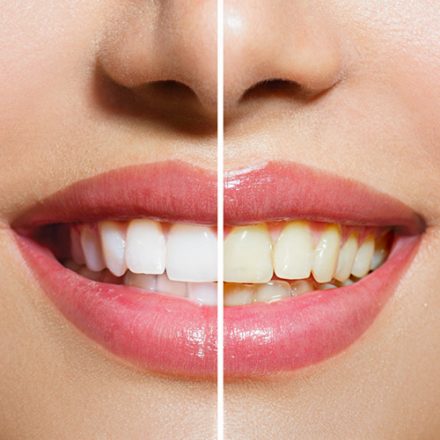
Teeth Whitening & Discoloured Teeth:
Teeth can be discoloured or stained in a number of ways.
Extrinsic staining is the name given to stains that develop on the surface of teeth and are usually the result of diet or lifestyle choices. Extrinsic staining can occur due to consumption of tea, coffee, wine, soft drinks, tobacco and other foods or drinks.
Intrinsic staining is when the inner layer of the tooth darkens. This can happen for a variety of reasons. Trauma to the tooth can cause internal bleeding that darkens the colour of the tooth. Genetic conditions can also cause teeth to form in an unusual colour. Use of certain antibiotics either before you were born or in childhood can cause staining of the inner layers of the teeth. Teeth treated with a root canal treatment can discolour over time as well. The inner layers of the teeth also gradually becomes more yellow as it ages.
Many stains can be treated by having your teeth cleaned professionally. This is usually the first treatment our dentists will perform in cases of discoloured teeth. More tenacious stains may also require bleaching of the teeth to completely remove them. We offer various bleaching and tooth whitening programs at AT Dental Health.
Extrinsic stains can usually be treated by applying a bleaching agent to the outside of your teeth. This can be done in office using our PolaOffice whitening system, also known as power bleaching. A strong bleaching gel is applied to the teeth and activated with a bright blue light, resulting in whiter teeth in as little as 45 minutes. With any whitening treatment, tooth sensitivity is a very common side effect. Therefore, our dentists will often recommend that you use a sensitivity reducing toothpaste before and after whitening.
Another option for bleaching extrinsic stains is using a bleaching tray at home loaded with our PolaDay or PolaNight whitening systems. Our dentists will take an impression of your teeth in order to construct a customised tray to hold the bleaching gel against your teeth. The frequency and duration of treatments, and the strength of the bleach will be determined by your dentist before commencing the whitening process. The bleach available for home use are not as strong as those that can be applied in office. This means that with this treatment, your teeth will not be as sensitive as in the in-office power bleaching, but will take longer to achieve the same degree of whitening.
Intrinsic stains are much more difficult to treat. Intrinsic stains that are a side effect of root canal treatments can be treated by applying a bleaching gel to the inside of the tooth rather than the outside. The bleach is replenished every week until the desired colour is achieved.
Other forms of intrinsic stains are difficult or impossible to treat by whitening. In these cases, covering up the discoloured areas will be the only option. Your dentist may recommend fillings, crowns, or veneers to improve the colour of these stains.
